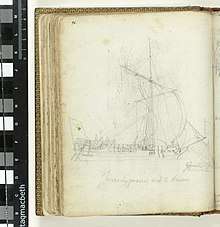Chialoup
Chialoup (or chaloup) was a type of sloop used in the East Indies, a combination of western (Dutch) and Nusantaran (Indonesian) technologies and techniques. Many of these "boat-ships" were produced by VOC shipwrights in Rembang and Juwana, where the majority of the workers were local Javanese. Chialoups were used by the Dutch East India Company and private merchant-sailors of western and Nusantaran origin.

Description

The chialoup sail plan mimics that used in sloops, with a combination of square-rigged and fore-and-aft sails. The boats are usually single-decked with one mast, sometimes with an added mizzen mast.[1]:34 While most such chialoups use a European-style central rudder, some are equipped with two side (quarter) rudders, a characteristic of Nusantaran boats. The length is between 15 and 25 meters, with a cargo bay almost 6 meters long. Depending on the size of the boat, crews run 20 to 40 people, with a typical load capacity of 72 to 144 metric tons.[2] In the syahbandar's (harbourmaster) record of Malacca a chialoup is listed carrying up to 200 tons of cargo and a crew of 75 people.[3] Chialoups on average were armed with 4 cannons, 1 swivel gun, and 7 snaphaunces.[4]
In the era after 1820 chialoups gradually disappeared from the "List of Ships and Sea Vehicles from the East Indies", a periodical published by the colonial government of the Dutch East Indies, and the term chialoup appeared more rarely in newspapers, replaced with kotter, a Dutch word for a type of sloop.[5][6]:42
See also
References
- Knaap, Gerrit (1996). Shallow Waters, Rising Tide. ISBN 978-90-67-18102-0.
- Groenewegen, G. (1789). Verzameling van vier en tachtig stuks Hollandsche schepen : geteekend en in koper gebragt. Rotterdam: J. van den Brink.
- Lee, Kam Hing (1986): 'The Shipping Lists of Dutch Melaka: A Source for the Study of Coastal Trade and Shipping in the Malay Peninsula During the 17th and 18th Centuries', in Mohd. Y. Hashim (ed.), Ships and Sunken Treasure (Kuala Lumpur: Persatuan Muzium Malaysia), p. 53-76.
- Knaap, Gerrit (1999). "Shipping and Trade in Java, c. 1775: A Quantitative Analysis". Modern Asian Studies. 33: 405–420.
- Bruyn Kops, G.F. De 1921. 'Vaartuigen'. In: Stibbe, D.G. & Spat, C. (eds.) Encyclopaedie van Nederlandsch-Indië. ‘s-Gravenhage: Nijhoff.
- Liebner, Horst H. (2016). Beberapa Catatan Akan Sejarah Pembuatan Perahu Dan Pelayaran Nusantara. Jakarta: Indonesian Ministry of Education and Culture.


.jpg)